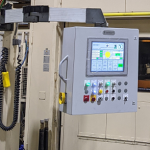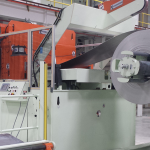
Control Upgrade
October 10, 2024
High Coil Feed Line Case Study
October 10, 2024
Control Upgrade
October 10, 2024
High Coil Feed Line Case Study
October 10, 2024Hydraulic overloads and die sensors offer a certain level of security, but tonnage monitors take press and die protection to the next level. Look at this article from 2019 Metalforming Magazine to learn more about the importance of tonnage monitoring systems.
5 Questions With An Expert: The Importance of Tonnage Monitoring
John Eby, Toledo Integrated Systems Toledo Transducers Inc.
1. Why is tonnage monitoring so important?
Imagine driving a car without a speedometer. You would be guessing your speed and struggling to stay within the speed limit. A tonnage monitor helps ensure that a stamping operation stays within the capacity limits of the press and die. Tonnage monitors notify the operator when the process exceeds these limits, and help the metal former make the best parts possible with the least amount of tonnage.
2. With hydraulic overloads and die protection already on the press, why add a tonnage monitor?
All three are important. Hydraulic overloads work great, but only for press-capacity protection. Die protection sensors help mistake-proof the process. Tonnage monitors confirm that the hydraulic overloads are properly set. They also allow the setting of high and low tonnage limits for the die—a parameter not addressed by hydraulic over-loads or die protection. Working within this tonnage limit is critical, especially when presses run in automatic mode with operators responsible for more than one machine.
3. What is "reverse" or "snapthrough" tonnage?
Reverse tonnage can be a press killer, generating severe shock waves that can adversely affect a press' drive components. In some cutting or blanking operations, reverse or snapthrough tonnage results when press tonnage builds and then the die breaks quickly through the material. Most press manufacturers tell us that press reverses tonnage readings should not exceed 10 percent of press capacity. This means a 400-ton press should not see more than 40 tons of reverse tonnage. Staggering punches or using dampener systems can help reduce reverse tonnage and increase press life.
4. What are some of the variables that affect tonnage?
Ram adjustment, stock thickness, part lubrication, loose tie rods, slug build-up, foreign material in the die, and other mechanical or die issues are just a few of the many variables. Tonnage readings should be consistent from hit to hit during production and from die set to die set.
5. Why are tonnage signatures important?
Most monitors provide peak tonnage readings, updated with each press stroke. Tonnage signatures tell the rest of the story. Each die, as it relates to the press, has its unique signature. These signatures are very repeatable unless something has changed with the die or press. Press manufacturers rate machine capacity at or near the bottom of the stroke, and all will provide press-rated tonnage curves and motion diagrams. By using this information, along with a resolver for press position and a tonnage signature, metal formers can compare the actual tonnage signature to the press capability specifications.
This type of resolver-based tonnage monitoring also referred to as critical curve monitoring (CCM) and through-the-stroke tonnage monitoring, can prove very helpful in ensuring that metalformers use the right die and press for the job. For example, consider an application where a 600-ton press rated at 120 tons at 2 in. off bottom is hitting at 130 tons. CCM in this case will notify the stamper of the issue before damage occurs to the press or the tool.

